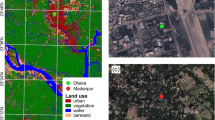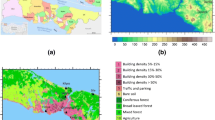Abstract
The statistical and dynamical characteristics of the urban heat island (UHI) intensity in Seoul are investigated for non-precipitation days and precipitation days using 4-year surface meteorological data with 1-h time intervals. Furthermore, the quantitative influence of synoptic pressure pattern on the UHI intensity is examined using a synoptic condition clustering method. The statistical analysis shows that the daily maximum UHI intensity in Seoul for non-precipitation days is strongest in autumn (4.8°C) and weakest in summer (3.5°C). The daily maximum UHI intensity is observed around midnight in all seasons except in winter when the maximum occurrence frequency is found around 08 LST. This implies that anthropogenic heating contributes to the UHI in the cold season. The occurrence frequency of the UHI intensity has a negatively skewed distribution for non-precipitation days but a positively skewed distribution for precipitation days. The amplitude of the heating/cooling rate and the difference in the heating/cooling rate between the urban and rural areas are smaller in all seasons for precipitation days than for non-precipitation days, resulting in weaker UHI intensities for precipitation days. The urban cool island occurs very often in the daytime, with an occurrence frequency being 77% of the total non-precipitation days in spring. The analysis of the impact of large-scale dynamical forcing shows that the daily maximum UHI intensity varies with synoptic pressure pattern, ranging from −22% in spring to 28% in summer relative to the seasonal mean daily maximum UHI intensity. Comparison of the UHI intensity calculated using station-averaged temperatures to that based on the conventional two-station approach indicates that local effects on the UHI intensity are minimized by using multiple-station data. Accordingly, an estimation of the UHI intensity using station-averaged temperatures for both urban and rural areas is suggested.










Similar content being viewed by others
References
Arnfield AJ (2003) Two decades of urban climate research: a review of turbulence, exchanges of energy and water, and the urban heat island. Int J Climatol 23:1–26
Atkinson BW (2003) Numerical modelling of urban heat-island intensity. Boundary-Layer Meteorol 109:285–310
Baik JJ, Kim YH, Chun HY (2001) Dry and moist convection forced by an urban heat island. J Appl Meteorol 40:1462–1475
Bejaran RA, Camilloni IA (2003) Objective method for classifying air masses: an application to the analysis of Buenos Aires’ (Argentina) urban heat island intensity. Theor Appl Climatol 74:93–103
Chow WTL, Roth M (2006) Temporal dynamics of the urban heat island of Singapore. Int J Climatol 26:2243–2260
Eliasson I (1996) Urban nocturnal temperatures, street geometry and land use. Atmos Environ 30:379–392
Fan H, Sailor DJ (2005) Modeling the impacts of anthropogenic heating on the urban climate of Philadelphia: a comparison of implementations in two PBL schemes. Atmos Environ 39:73–84
Figuerola PI, Mazzeo NA (1998) Urban–rural temperature differences in Buenos Aires. Int J Climatol 18:1709–1723
Gedzelman SD, Austin S, Cermak R, Stefano N, Partridge S, Quesenberry S, Robinson DA (2003) Mesoscale aspects of the urban heat island around New York City. Theor Appl Climatol 74:29–42
Jauregui E (1997) Heat island development in Mexico City. Atmos Environ 31:3821–3831
Kalnay E, Kanamitsu M, Kistler R, Collins W, Deaven D, Gandin L, Iredell M, Saha S, White G, Woollen J, Zhu Y, Chelliah M, Ebisuzaki W, Higgins W, Janowiak J, Mo KC, Ropelewski C, Wang J, Leetmaa A, Reynolds R, Jenne R, Joseph D (1996) The NCEP/NCAR 40-year reanalysis project. Bull Am Meteorol Soc 77:437–471
Kim YH, Baik JJ (2002) Maximum urban heat island intensity in Seoul. J Appl Meteorol 41:651–659
Kim YH, Baik JJ (2004) Daily maximum urban heat island intensity in large cities of Korea. Theor Appl Climatol 79:151–164
Kim YH, Baik JJ (2005) Spatial and temporal structure of the urban heat island in Seoul. J Appl Meteorol 44:591–605
Klysik K, Fortuniak K (1999) Temporal and spatial characteristics of the urban heat island of Lodz, Poland. Atmos Environ 33:3885–3895
Lee SH, Park SU (2008) A vegetated urban canopy model for meteorological and environmental modelling. Boundary-Layer Meteorol 126:73–102
Lee SH, Song CK, Baik JJ, Park SU (2009) Estimation of anthropogenic heat emission in the Gyeong-In region of Korea. Theor Appl Climatol 96:291–303
Makar PA, Gravel S, Chirkov V, Strawbridge KB, Froude F, Arnold J, Brook J (2006) Heat flux, urban properties, and regional weather. Atmos Environ 40:2750–2766
Morris CJG, Simmonds I (2000) Associations between varying magnitudes of the urban heat island and the synoptic climatology in Melbourne, Australia. Int J Climatol 20:1931–1954
Morris CJG, Simmonds I, Plummer N (2001) Quantification of the influences of wind and cloud on the nocturnal urban heat island of a large city. J Appl Meteorol 40:169–182
Oke TR (1973) City size and the urban heat island. Atmos Environ 7:769–779
Oke TR (1982) The energetic basis of the urban heat island. Q J R Meteorol Soc 108:1–24
Oke TR, Maxwell BB (1975) Urban heat island dynamics in Montreal and Vancouver. Atmos Environ 9:191–200
Park SU, Yoon IH (1991) The characteristic features of local weather phenomena under the various synoptic winds over South Korea. J Korean Meteorol Soc 27:87–118
Segal M, Arritt RW (1992) Nonclassical mesoscale circulations caused by surface sensible heat-flux gradients. Bull Am Meteorol Soc 73:1593–1604
Szymanowski M (2005) Interactions between thermal advection in frontal zones and the urban heat island of Wroclaw, Poland. Theor Appl Climatol 82:207–224
Unger J (1996) Heat island intensity with different meteorological conditions in a medium-sized town: Szeged, Hungary. Theor Appl Climatol 54:147–151
Vukovich FM, Dunn J, Crissman B (1976) A theoretical study of the St. Louis heat island: the wind and temperature distribution. J Appl Meteorol 15:417–440
Yague C, Zurita E, Martinez A (1991) Statistical analysis of the Madrid urban heat island. Atmos Environ 25B:327–332
Acknowledgments
The authors are very grateful to two anonymous reviewers for providing valuable comments on this paper. This work was funded by the Korea Meteorological Administration Research and Development Program under Grant CATER 2006-2202.
Author information
Authors and Affiliations
Corresponding author
Rights and permissions
About this article
Cite this article
Lee, SH., Baik, JJ. Statistical and dynamical characteristics of the urban heat island intensity in Seoul. Theor Appl Climatol 100, 227–237 (2010). https://doi.org/10.1007/s00704-009-0247-1
Received:
Accepted:
Published:
Issue Date:
DOI: https://doi.org/10.1007/s00704-009-0247-1




